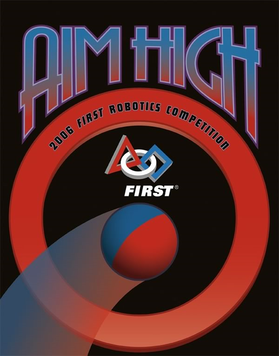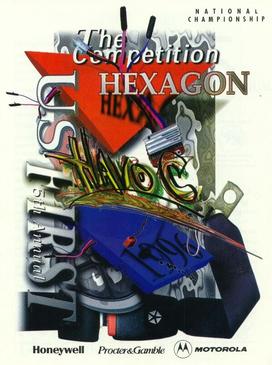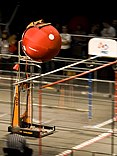
A tennis court is the venue where the sport of tennis is played. It is a firm rectangular surface with a low net stretched across the centre. The same surface can be used to play both doubles and singles matches. A variety of surfaces can be used to create a tennis court, each with its own characteristics which affect the playing style of the game.

Softball is a sport similar to baseball, and it is played with a larger ball on a smaller field and with only underhand pitches permitted. Softball is played competitively at club levels, the college level, and the professional level. The game was first created in 1887 in Chicago by George Hancock.

FIRST Frenzy: Raising the Bar was the 2004 game for the FIRST Robotics Competition. The game included elements from previous years' games, including mobile goals, "capping" goals with large inflatable balls, and others. In Raising the Bar, teams could score by having their human player score purple balls in any of the goals, capping the goals with a multiplier ball, or hanging their robot suspended from the 10-foot (3.0 m) high 'chin up bar'. In the qualifying matches, Teams competed in 2-member randomly generated alliances. In the elimination rounds, 3-member alliances competed against each other with one team sitting out each match. The alliance that won two matches advanced in the tournament.

The Apollo command and service module (CSM) was one of two principal components of the United States Apollo spacecraft, used for the Apollo program, which landed astronauts on the Moon between 1969 and 1972. The CSM functioned as a mother ship, which carried a crew of three astronauts and the second Apollo spacecraft, the Apollo Lunar Module, to lunar orbit, and brought the astronauts back to Earth. It consisted of two parts: the conical command module, a cabin that housed the crew and carried equipment needed for atmospheric reentry and splashdown; and the cylindrical service module which provided propulsion, electrical power and storage for various consumables required during a mission. An umbilical connection transferred power and consumables between the two modules. Just before reentry of the command module on the return home, the umbilical connection was severed and the service module was cast off and allowed to burn up in the atmosphere.

A baseball field, also called a ball field or baseball diamond, is the field upon which the game of baseball is played. The term can also be used as a metonym for a baseball park. The term sandlot is sometimes used, although this usually refers to less organized venues for activities like sandlot ball.

Aim High was the 2006 game for the FIRST Robotics Competition. The competition involved teams competing to gain points by delivering balls into goals and positioning their robots in certain positions on the playing field. The teams took it in turn to provide defense and attack.

Rug Rage was the 1993 game of the FIRST Robotics Competition. In it, teams competed individually to score as many balls as possible in their goal.

Hexagon Havoc was the 1996 game for the FIRST Robotics Competition. Seeding games of 1-on-1-on-1 were played double-elimination to determine the teams for the finals rounds. In the finals, robots played 1-on-1 in a best 2 out of 3.

Ladder Logic was the game for the 1998 FIRST Robotics Competition.

Hangin'-A-Round was the name of the robotics contest at the 2006-2007 FIRST Vex Challenge (FVC). The contest involved building a robot from a kit that could attain a higher score than the opposition by placing the softballs into the colored goals, possessing the “atlas ball”, and by being parked on the platform or hanging from the bar.

In the 2007-2008 FIRST Tech Challenge robot competition, Quad Quandary is the first challenge theme replacing the former FIRST Vex Challenge, with similar general rules regarding the specifications of the robot and the game play. Unlike the previous challenge, Hangin'-A-Round, Quad Quandary makes use of small rings and movable goal posts.

Half-Pipe Hustle was the first official FIRST Vex Challenge (FVC) game, taking place in 2005–2006. In this challenge, robotics teams built robots from the Vex design kit to compete in competitions across the United States and in other nations, in matches consisting of a 45-second autonomous period, followed by a 2-minute driver control period in which the robots are controlled by team drivers using remote controls.

Maize, also known as corn in North American and Australian English, is a tall stout grass that produces cereal grain. It was domesticated by indigenous peoples in southern Mexico about 9,000 years ago from wild teosinte. Native Americans planted it alongside beans and squashes in the Three Sisters polyculture. The leafy stalk of the plant gives rise to male inflorescences or tassels which produce pollen, and female inflorescences called ears. The ears yield grain, known as kernels or seeds. In modern commercial varieties, these are usually yellow or white; other varieties can be of many colors.

Hot Shot! is the robotics competition event in the 2009-2010 FIRST Tech Challenge. Two teams compete to score points by depositing whiffle balls into designated areas.
Breakaway is the game for the 2010 FIRST Robotics Competition, announced on January 9, 2010. Robots direct soccer balls into goals, traverse "bumps" in the field, suspend themselves and each other on towers, and/or go through a tunnel located in the center of the field.

Bowled Over!, released on 10 September 2011, is the 2011–12 robotics competition for FIRST Tech Challenge. Two alliances compete to score racquetballs into alliance-colored scoring goals. The name refers to two bowling balls on the field used for scoring points.
VEX Robotics is a robotics program for elementary through university students and a subset of Innovation First International. The VEX Robotics competitions and programs are managed by the Robotics Education & Competition Foundation (RECF). In April 2018, VEX Robotics Competition was named the largest robotics competition in the world by Guinness World Records.

FIRST Steamworks, stylized as FIRST STEAMworks, was the FIRST Robotics Competition game for the 2017 season. As in past games, two alliances of three individual teams and their robots compete on a field to score "match" point to win the game and ranking points to advance to playoff rounds. The game has a steampunk theme and teams are required to shoot wiffle balls which represent fuel into a simulated boiler which transfers the generated steam into an airship in the middle of the field. Each alliance has one airship, which they pressurize with steam from the boiler and load with plastic gears from the field. At the end of the match, robots can climb and hang on team-supplied ropes attached to the airship for additional points.

Rapid React, stylized as RAPID REACT and officially known as Rapid React presented by The Boeing Company for sponsorship reasons, is the FIRST Robotics Competition (FRC) game for the 2022 season. The game is themed around transportation as part of the FIRST-wide FIRST Forward theme for 2021-2022.

Charged Up, stylized as CHARGED UP and officially known as Charged Up presented by Haas for sponsorship reasons, was the FIRST Robotics Competition game for the 2023 season. The game is part of the FIRST-wide FIRST Energize theme for the 2022-2023 season, which focuses on energy and sustainable development. The season's kickoff event occurred on January 7, 2023, and was streamed live on Twitch.




















